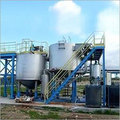Even today, most of the developing countries discharge their industrial or domestic waste through water without any treatment. There are only few countries who discharge the waste water after giving primary treatment. But this treatment is not sufficient for environments and its inhabitants. Around the world, water is responsible of about 80% of diseases. Thus, treating water is very important so as to save environment from water bore diseases such as typhoid, cholera, jaundice and more. For the said purpose sewage treatment plant are designed, mainly to treat the sewage water and remove the most of contaminants from the waste water and sewage water. This treatment includes physical, biological and chemical processing to remove contaminant. In short, sewage treatment plants act as aid for treating water and giving back clean water to environment.
Overview
Sewage treatment plants are implemented to provide an environmental friendly fluid water or solid waste that is suitable for use. To built effective sewage plant, appropriate conveyor and infrastructure has to be built to regulate sewage water on timely basis. The quality and amount of treatment to be given varies from water to water. Some sewage water requires less treatment while other requires heavy and specialized treatment to make it an effluent fluid. Generally, most of the waste water is treated thorough sedimentation process. In this solid particles are separated from waste water.
Sewage Plants and World
With the growing health awareness and scarcity of water worldwide, many countries are implementing sewage treatment plants so as to reuse the same water by cleaning it. Since water is renewable resource, same water can be used for different purposes, if properly treated. Sewage water not only made the water contaminant free but also made it available for re-use.
Many developed countries had implemented sewage treatment plants to encourage re-useability of water. Israel have about 50% of agricultural water for irrigation purpose which is supplied through reclaimed sewer water. Singapore is the only country that has implemented sewage treatment plants to reuse the sewage water for drinking purposes on a production scale. India also have contributed towards environments by installing water and waster treatment plants for treating polluted water.
Overview
Sewage treatment plants are implemented to provide an environmental friendly fluid water or solid waste that is suitable for use. To built effective sewage plant, appropriate conveyor and infrastructure has to be built to regulate sewage water on timely basis. The quality and amount of treatment to be given varies from water to water. Some sewage water requires less treatment while other requires heavy and specialized treatment to make it an effluent fluid. Generally, most of the waste water is treated thorough sedimentation process. In this solid particles are separated from waste water.
Sewage Plants and World
With the growing health awareness and scarcity of water worldwide, many countries are implementing sewage treatment plants so as to reuse the same water by cleaning it. Since water is renewable resource, same water can be used for different purposes, if properly treated. Sewage water not only made the water contaminant free but also made it available for re-use.
Many developed countries had implemented sewage treatment plants to encourage re-useability of water. Israel have about 50% of agricultural water for irrigation purpose which is supplied through reclaimed sewer water. Singapore is the only country that has implemented sewage treatment plants to reuse the sewage water for drinking purposes on a production scale. India also have contributed towards environments by installing water and waster treatment plants for treating polluted water.
